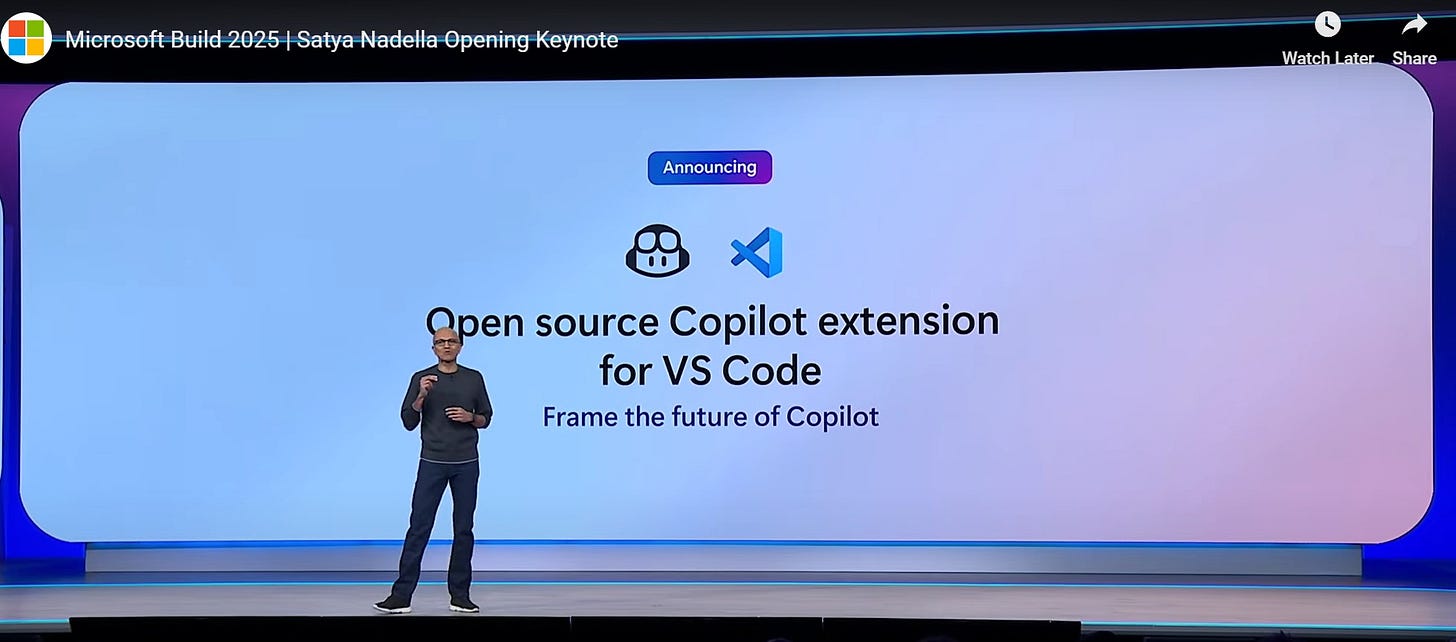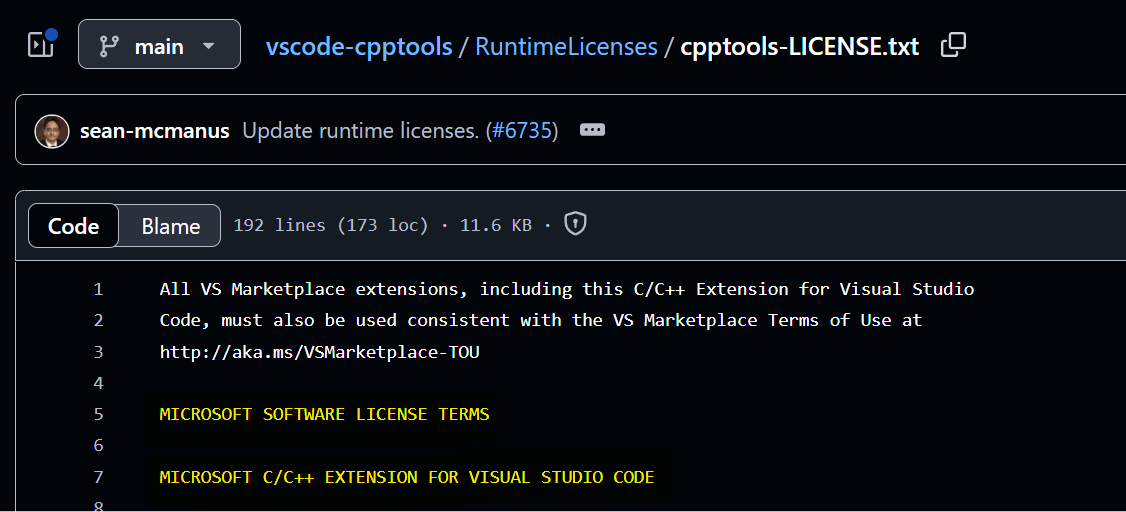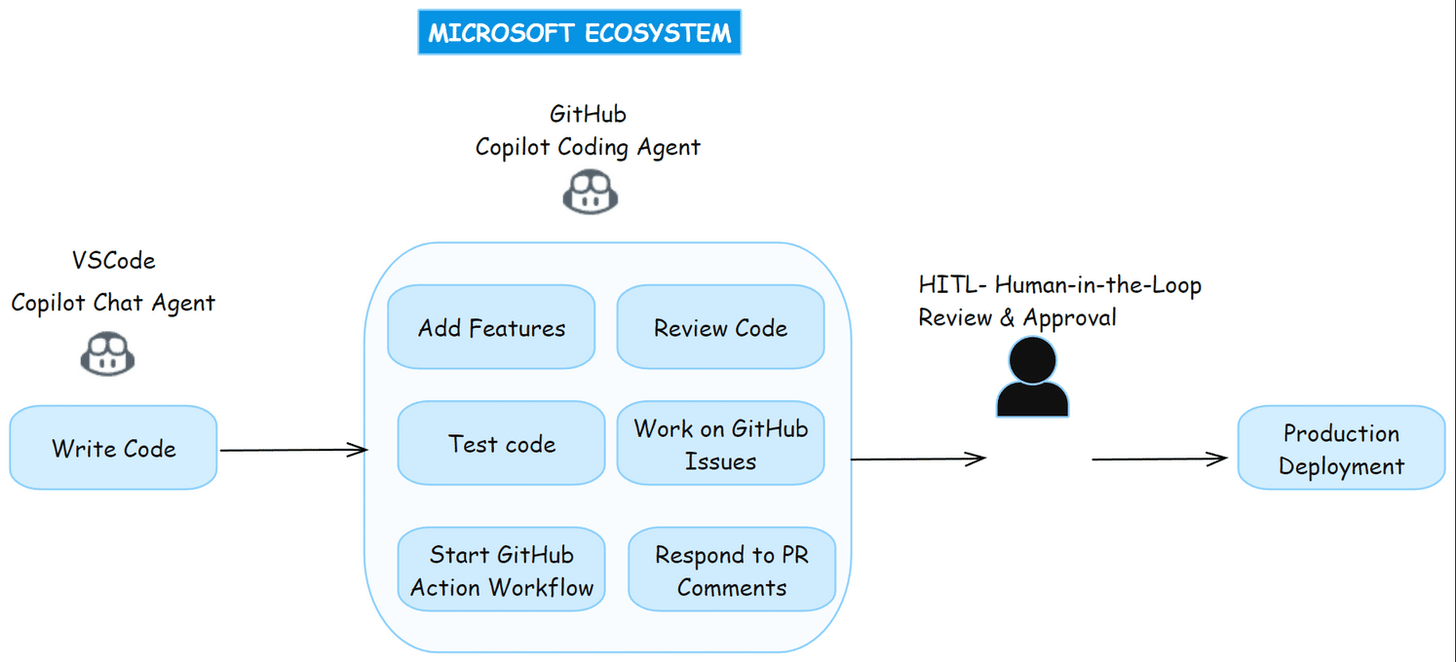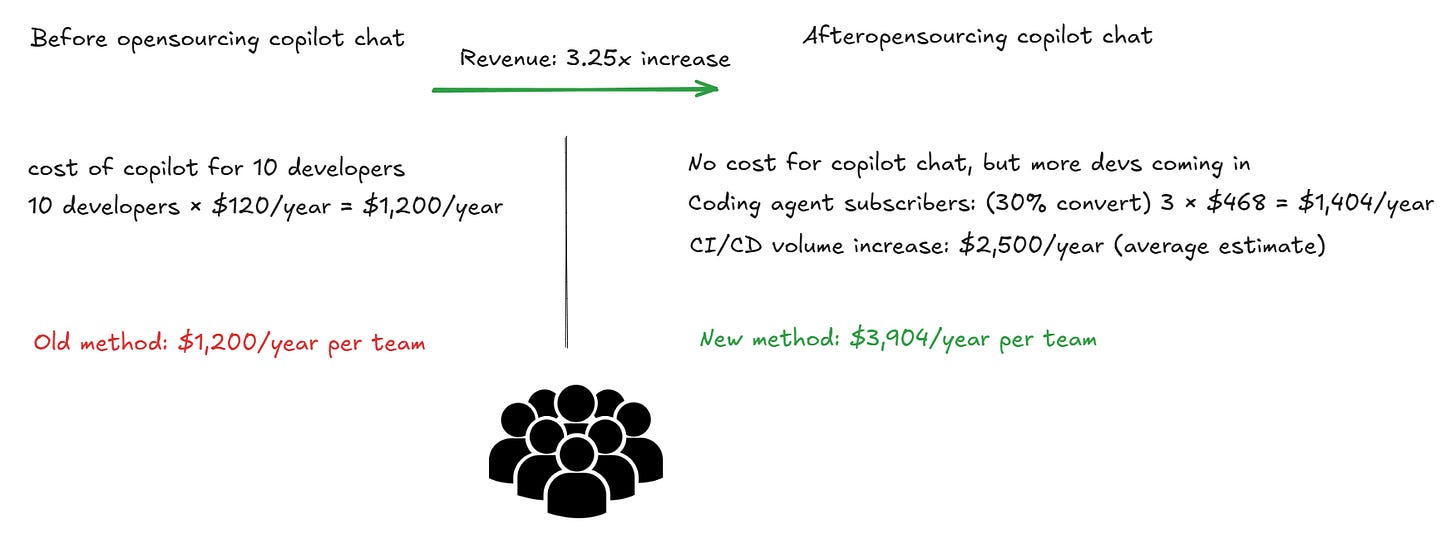It’s been less than a month since we covered the silent battle around AI agents and workflows, and now another contest is heating up. This time, the AI code editor space is where the competition is intensifying.
The AI-first coding race pivoted at Microsoft Build 2025, when Satya Nadella announced Microsoft would open-source GitHub Copilot Chat and refactor its relevant components into the core of Visual Studio Code. This wasn't just another announcement, but a calculated strategic move.
VS Code being a successful opensource project on GitHub over the last decade, open sourcing the GitHub Copilot Chat extension now will unlock more community contributions, boost trust through transparency, and make VS Code the go-to place for AI-powered coding.
The biggest shift? Microsoft is finally baking AI directly into VS Code itself, not just as add-ons, but as core features every developer gets by default. This transforms VS Code from "An editor that can use AI" into a true "AI-native editor" by default.
First, a bit of history
VS Code, which went open source in 2015, quickly became the editor, millions of developers open every morning. This success created an entire extension marketplace ecosystem within Microsoft's orbit. The company has carefully nurtured this advantage for years, watching as competitors emerged from its own success.
Cursor and Windsurf, both forks of VS Code, gained traction by adding proprietary AI chat and code-generation layers on top of editor. They were essentially building their business on Microsoft's work while adding the AI features developers craved. For a while, Microsoft seemed content to let them operate.
A Quiet Warning Shot
Then came the first strategic move. Last month, Microsoft quietly locked its extension marketplace so that forks like Cursor and Windsurf could no longer fetch Microsoft-licensed extensions. No big announcement, no public confrontation, just a single line of code change that sent a clear message.
This subtle but powerful change means that if you are not using the official VS Code Editor, you are denied access to Microsoft-licensed extensions. For example, while VS Code itself is under the MIT license, many, like C/C++ extension, are under Microsoft's proprietary license. These licensing terms have existed for years, but now Microsoft has made code changes that actively check and block non-official editors from accessing these extensions. So, anyone can fork VS Code, but they can't use the Microsoft-licensed extensions.
Microsoft was reinforcing boundaries. The rich extensions they've built would remain exclusive to their official editor, not for competitors building on their foundation.
This was a deliberate first step, restricting the value these competitors could offer while avoiding any direct confrontation that might generate negative press. Microsoft is well within its rights to do this and served a warning shot to forks on their dependence.
The AI Native Move
Just as people were settling on the extension restrictions, Microsoft made a major move at Build 2025. Two key announcements that seemed like typical product updates but were actually calculated moves against Cursor and Windsurf.
Copilot Chat will be moved to MIT license and core features will be integrated with VS Code core.
Copilot has evolved from being a coding assistant to Coding Agent. It can now handle entire tasks like autonomously fixing bugs, add new features, and maintain code without constant guidance. Developers can simply assign GitHub issues to Copilot, and it works just like any other team member, analyzing the problem, writing code, running tests, and creating pull requests for review.
Why Open Source and Why Now? What is Microsoft Really After?
The Scale Behind the Strategy
The numbers reveal why Microsoft is making these moves. With 15 million developers already using GitHub Copilot and over 230,000 organizations—including 90% of the Fortune 500—building AI agents through Copilot Studio, Microsoft has built a massive developer ecosystem that extends far beyond any single tool.
While VS Code itself doesn't generate direct revenue, it serves as the daily entry point into Microsoft's developer ecosystem.
The real concern isn't losing subscription fees from an editor switch but preventing competitors from establishing themselves as the preferred code editor.
Owning the Entire Software Development Lifecycle
Microsoft isn't just improving tools. They're building the entire AI workflow. The system now includes two agents.
An "Agent Mode" in Copilot chat that works live with developers.
An Autonomous Background Agent (Copilot Coding Agent) that handles assigned tasks in the GitHub.
Microsoft is stitching together an end-to-end development workflow that keeps developers entirely within their ecosystem. The copilot agent writes code in VS Code and the coding agent handles issues, review code, and raise and pull requests in GitHub and can even trigger GitHub Actions to automate the entire workflow. The whole process feels seamless because it's all Microsoft agents working together.
This isn't about winning the editor wars. It's about owning the entire software development lifecycle. Once developers are used to this level of automated agentic workflow, they’re less likely to switch to a different editor, and even less likely to move away from the Microsoft ecosystem altogether.
Open-Source What Others Are Trying to Sell
By open sourcing Copilot Chat, Microsoft is turning a paid feature into something the whole community can use and improve. This move does more than just match what competitors offer.
Now, developers get advanced AI chat features without having to switch to a different editor. Instead of paying for these tools in a fork, they can use and even contribute to them in the official VS Code. At the same time, Microsoft builds goodwill by inviting the developer community to be part of the innovation, rather than keeping these capabilities locked away.
Platform Advantage Over Feature Competition
Microsoft learned from past battles that trying to compete on features alone often fails when startups can move faster. Instead, they're using their platform advantage, as they own multiple critical pieces of the developer toolchain, they can create an integrated experience that's hard for smaller companies to replicate.
Even if Cursor builds better AI features, they can't offer the complete automated workflow that Microsoft provides from writing code in the editor to automatically deploying through GitHub Actions.
The Business Model
Ultimately, Microsoft is betting that control over the developer workflow is more valuable than direct revenue from individual tools. They're willing to give away Copilot Chat because keeping developers in their ecosystem drives adoption of Copilot coding Agent, GitHub, Azure, and their other services where the real money is made. It's the same playbook that made VS Code successful in the first place—be free, be open, be indispensable, and monetize through the platform.
But let's look at the numbers behind this strategy. While Microsoft appears to be giving away valuable AI capabilities for free, the financial calculation tells a different story.
What does this move actually cost Microsoft, and what do they gain in return? Read below.
What are they Losing?
Microsoft previously charged developers $10 per month for Copilot Pro subscription. With open-sourcing copilot chat, developers can now integrate with their local models and get unlimited AI assistance at no cost. This represents a direct revenue loss of $120 per year for each existing Pro subscriber.
Loss per developer: $120/year
What are they Gaining?
Once the developers are in the GitHub ecosystem, they experience AI help- Coding Agent. The GitHub Copilot coding agent feature is available in the pro+ plan which is $39/month tier. Developers who upgrade to coding agent generate $468 per year in revenue.
Gain per converted user: $468/year
The CI/CD Revenue Opportunity:
Copilot chat attracts more developers to the GitHub ecosystem, which naturally increases usage of GitHub Actions for CI/CD. A typical development team spends $200-500 per month on CI/CD pipelines, so with 5x-10x more developers using GitHub, CI/CD usage revenue scales proportionally. This creates significant revenue growth from existing services without changing pricing.
Increased CI/CD revenue: $1,000-5,000 per team per year.
The diagram below illustrates this shift. With just 3 out of 10 developers upgrading and more teams using CI/CD, the new method earns over three times more each year.
After all the calculation we could see, Microsoft will gain 2-3x revenue increase from ecosystem expansion.
What do developers think about this
Within hours of the announcement, developer conversations took off. Many view the open Copilot Chat as a big win, ensuring VS Code’s position as the go-to editor and helping Microsoft maintain strong influence over the AI Editor ecosystem.
Why Developers Should Care
Microsoft's decision to open-source GitHub Copilot Chat creates significant opportunities for AI-assisted development, especially around code generation capabilities.
Prompt Engineering and Context Handling
Open sourcing reveals how exactly prompts are structured for coding tasks like completion, refactoring, and testing. Developers can see how code context, from active files to project structure, is collected and passed to AI models. This knowledge helps developers optimize context selection and craft better prompts for their own tools.
Enhanced Code Generation
With access to the source code, developers can directly improve the code generation process. They can now contribute new features that make code suggestions more accurate and relevant.
Community Innovation
Open-source means faster bug fixes, community-contributed features, and organic improvements in accessibility and tooling. The entire developer community can contribute to making code generation better, creating a self-improving ecosystem that benefits everyone.
While this sounds like a win-win scenario for developers and Microsoft alike, the strategy isn't without risks. However, Microsoft's plan isn't guaranteed to succeed, and their competitors aren't sitting idle.
What might not go well?
While Microsoft's open-sourcing strategy looks promising on paper, several challenges could derail their plans to dominate the AI coding space.
Cursor and Windsurf have built good user experiences that go beyond just AI chat integration. Cursor's Agent delivers lightning-fast code generation while maintaining developer flow state, with an intuitive UI that feels natural and responsive.
Windsurf's Cascade agent offers smooth, multi-file editing experiences with better context awareness, plus they can deploy projects directly to platforms like Netlify. These aren't just feature additions to existing editors, they're ground-up innovations designed specifically for AI-first development workflows.
We need to wait and see if this open-source strategy will work for Microsoft, as Cursor and Windsurf can move faster and enhance the developer experience with better deployment tools. If they start offering more features with free versions while keeping their smooth experience, developers will probably stick with what works better instead of switching to Microsoft.
Open source doesn't always win, but the best user experience does.
What Comes Next
Microsoft has shown they're willing to give away valuable AI capabilities to maintain their platform dominance. Expect more AI features into the core VS Code.
Watch how competitors respond. Will they find new ways to stand out, or will we see a wave of acquisitions as smaller AI coding companies get absorbed by larger platforms? The companies that survive will need to offer something Microsoft can't or won't provide.
The Bottom Line
Microsoft has turned open source into a competitive weapon. By giving away what others charge for, they're making it incredibly difficult for competitors to justify their existence while strengthening their agentic ecosystem.
For developers, this means better tools at no extra cost. For Microsoft's competitors, it means the free ride is over, and it’s now time to innovate or find a new game to play.
Hope this write-up sparked some questions and ideas about the AI code editor space.
What are your thoughts on this? share it with us…









